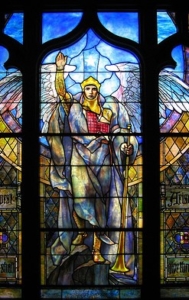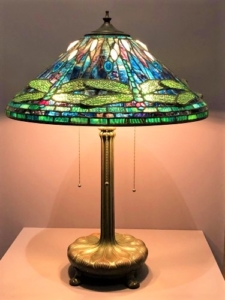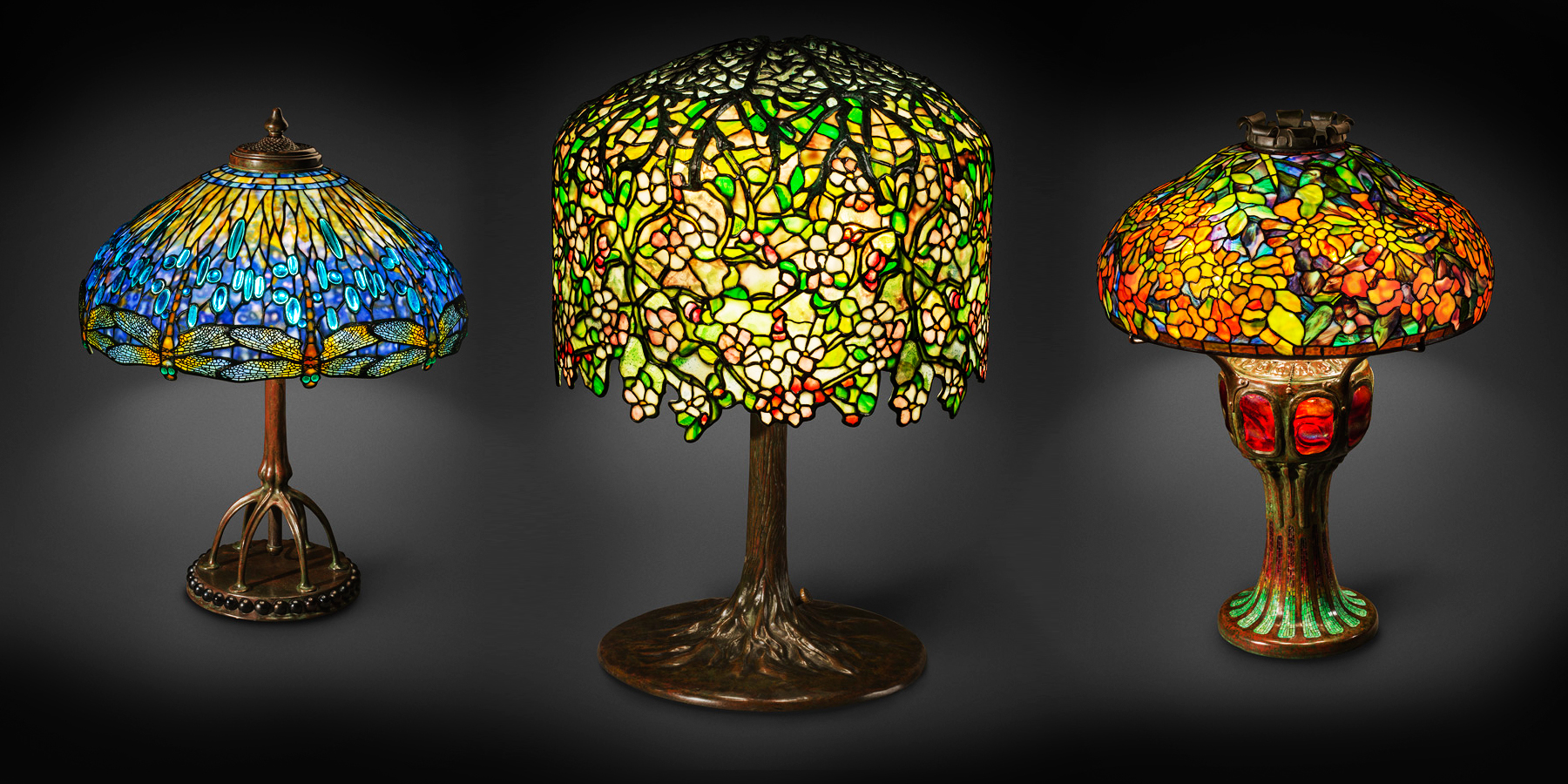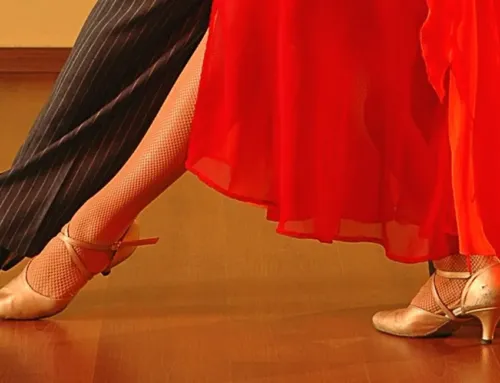“Color is to the eye what music is to the ear.” ~ Louis Comfort Tiffany
The name Tiffany usually calls to mind fine jewelry, which is thanks to Charles Lewis Tiffany (1812-1902), whose enterprising work established what today we know as Tiffany & Co.
Historian Paul Johnson said that Charles Lewis, originally a merchant of silverware and fine china, capitalized on the political instability of the post-Napoleon era to buy mountains of precious jewels from European aristocratic families. From there he became a jeweler to the gilded age of America following the Civil War.
It was through the crafting of jewelry that his son, Louis Comfort Tiffany, entered the field of glass work. There he established an entirely new form of art – fashioning lamps, vases, panels, arbors, even entire walls and ceilings from stained glass.
Art Nouveau
Louis Comfort inherited his father’s business in 1902 but was already well-established as an artist and entrepreneur in his own right with several companies dedicated to interior design and glasswork. He was commissioned by President Chester Arthur in 1885 to conduct a full-scale renovation of the interior of the White House. Teddy Roosevelt later removed and destroyed every bit of Tiffany’s work, as the two were rivals and hostile neighbors from Oyster Bay, NY. It’s hard to imagine the cultural loss of such pettiness.
Although Tiffany did not initiate the trend, he was perhaps the most representative figure of the movement of the late 19th century called Art Nouveau. Whereas impressionism (a parallel movement at the time) was a rebellion against the strictures of the traditional art schools, art nouveau challenged the prevailing notions that high art had to focus on strictly religious or classical subjects. Tiffany nonetheless created many religious works, particularly in stained glass for churches.
Art Nouveau was based on the idea that art, to be authentic, had to reflect forms of nature. The contemporary Pre-Raphaelite movement fully expressed this idea with a naturalism in art that was quite remarkable. On the other hand, certain radicals like Picasso completely rejected art as a reflection of nature and initiated art’s long slide into the utterly meaningless forms of “modern” art of 20th century (surrealism, cubism, Dadaism).
As an artistic trend, Art Nouveau did not last long, but it did leave an incredible legacy both in painting and glass. (It was supplanted by Art Deco in the twenties, another artistic trend that didn’t last long). With regard to Tiffany’s place in the overall movement, he was essentially a landscape artist who worked in glass to infuse natural scenes with light – a truly wonderful convergence of form, style and talent.
Tiffany the businessman
Tiffany’s genius was both artistic and entrepreneurial. He established not only a new form of art but a business enterprise to mass produce his art and distribute it on a wide scale. The exquisite quality of his artwork was not due only to his own talent in glasswork – which was prodigious in itself – but in his careful selection of other craftsmen who equaled and augmented his talent in creating artifacts of enormous beauty.
His glass and decorating company on Long Island employed over a thousand workers by the turn of the century including a hundred of the finest stained glass artists in the world, whom he paid top wages. He also employed hundreds of women in this skilled work. Tiffany considered women to be the better craftsmen at the detail work of stained glass because of their smaller fingers and their finer sense of color than men.
A new art form
Tiffany did not invent glasswork. The use of glass as a substance for art and decor has a 5,000 year history, dating back to Mesopotamia. The art of stained glass is at least as old as the early Middle Ages, testified to by Europe’s Gothic cathedrals, many of whose glorious windows remain intact more than 900 years after their creation. In fact, many of Tiffany’s greatest works were stained glass windows he created for churches and which remain in their settings to this day.
But Tiff any did something unique that had never been done in glass. He created glass with variegated colors in the glass itself. That may sound unremarkable until one considers that stained glass up to that point was colored by hues of stain (hence the name) in individual pieces of glass or was painted on the surface of the glass to achieve its artistic effect.
any did something unique that had never been done in glass. He created glass with variegated colors in the glass itself. That may sound unremarkable until one considers that stained glass up to that point was colored by hues of stain (hence the name) in individual pieces of glass or was painted on the surface of the glass to achieve its artistic effect.
Tiffany’s stained glass technique was the work of creating pictures using glass itself as his paint brush. His pictures were not on glass or created with glass. The artistic scenes themselves are inherent in the glasswork. Essentially, his windows were like watercolor paintings with inner luminosity and depth.
To create them, he used a variety of techniques and glasswork: mottled glass (varying in intensity of shading and color); confetti glass (flaked); marbled glass (with marbleizing streaks); plated glass (large panels – unheard of in traditional stained glass); rippled glass (for water and sky effects); among other techniques. These bestowed a depth of perspective and luminosity to his scenes that could not be achieved in a two-dimensional painting or even in traditional modes of stained glass.
Many of his masterpieces are in museums and homes today, but they were all created originally for environments in which natural light was meant to filter through them and illumine their colors naturally.
The glass lamps
It has been said that Tiffany lamps are not lamps, they are an art form in themselves. I would fully agree with that assessment. Any art form that inspires whole industries of cheap imitations (consider, for example, the tiffany-style overhead lamps in all Applebee’s restaurants) as well as serious attempts at counterfeiting, is a cultural phenomenon, and that surely can be said of Tiffany lamps.
Aprop os of our theme of beauty, we must acknowledge the role of light itself as an element of art. From time immemorial, artists have used light to enhance their works of art: the penetration of the light through the colored shards of stained glass windows into the dark naves of cathedrals; the chiaroscuro (dark-light) contrasts of Caravaggio; Rembrandt’s shimmering highlights of human faces; the glowing landscapes of Turner; the vibrant colors of the Impressionists, to name just a few of the more familiar examples.
os of our theme of beauty, we must acknowledge the role of light itself as an element of art. From time immemorial, artists have used light to enhance their works of art: the penetration of the light through the colored shards of stained glass windows into the dark naves of cathedrals; the chiaroscuro (dark-light) contrasts of Caravaggio; Rembrandt’s shimmering highlights of human faces; the glowing landscapes of Turner; the vibrant colors of the Impressionists, to name just a few of the more familiar examples.
Light expresses the essential quality of beauty – radiance. The ancients called it claritas, by which they meant color or a certain character of luminosity that all true beauty possesses.
Tiffany did something wholly new with light: he located the light source of his art inside the artwork so that the beauty would radiate outward from an inner center. This was something that could only be hinted at in the great stained glass works of medieval churches, which brought out the greatest beauty of the windows only when the light shone through the glass from an outside source.
With Tiffany lamps, the viewer could now see the beauty up close, personally, and in great detail. It was as if the radiance beckoned the viewer to look inward.
The highlight video below provides a look into what it must have been like for the workers in Tiffany’s Long Island plant to handcraft one of those precious lamps. Following the video I’ve noted a few summary points about Tiffany’s lamps to help you more fully appreciate the kind of unique artistic treasures Tiffany gave to the world.
The making of the Tiffany “Poppy” lamp (duration, 3:03)
Summary
A few summary points about Tiffany lamps may stimulate the reader to do more research into this inspirational art phenomenon. In fact, there are many more videos of similar quality on YouTube detailing the creation of other types of lamps.
Voluminous amounts of glass:
A Tiffany lamp can contain upwards of a thousand pieces of glass, each hand blown and hand cut. Some designs of the famous Wisteria lamp may contain as many as two thousand individual pieces of glass, never to be reproduced.
Nature themes:
Each Tiffany lamp is modeled after a lovely flower and sometimes includes as a decorative motif delicate creatures, such as peacocks, dragonflies, birds, butterflies, and even fish.
Originality of design:
Tiffany lamps often broke with the traditional pattern of conical, flat-bottomed lampshades; many were boxy, rounded, squared, or open-topped, and numerous models ended in uneven edges styled to make them look like an expression of the plant’s natural form.
Decorative bases:
The bases and stems of Tiffany lamps were made of bronze and were unique art forms in themselves, crafted to enhance the pattern and style of the shade; the first lamp stands were made for oil lamps and later to accommodate what was in Tiffany’s day a new technology – electricity!
The lamp in the video is not an original Tiffany, of course, but if the attempt to imitate the splendid process is so beautiful, imagine what delight must have inspired the original craftsmen (and women) in their creative work!

Soul Work
Louis Comfort Tiffany was a uniquely gifted artist, but he was also a practical man of business who interpreted correctly the desires of his age for fine art that was accessible to the common man.
Tiffany’s art was attractive because it was full of light. As a spiritual matter, is your life full of light? Do you read the Scriptures regularly to be enlightened by Truth? Is Christ the Light at the center of everything so that, like a Tiffany lamp, He radiates through you outward into the world? We are supposed to be the “light of the world” and a “lamp set on a lamp stand” (Matthew 5:15) –bearers of His Light to the world.
Take a moment to ask yourself some culture questions as well: How refined is your artistic sensibility? Do your artistic standards exceed those of the Disney-fied pop culture in which we live? Have you ever created a thing of beauty simply for the joy of engaging in a creative act? Have you ever created something for the purpose of enriching the life of someone else?
Do a check on your surroundings. If it is possible to change or upgrade your artistic tastes in art and culture, perhaps the story of the work of Tiffany will inspire you to do so. We don’t have to buy Tiffany lamps to decorate our living and working spaces (today that would take millions!) but everyone can add color, refinement, and beauty into a culture that is declining into banality and ugliness for lack of standards of beauty.
You be that new standard!
—–
Source: Paul Johnson, Creators: From Chaucer and Dürer to Picasso and Disney (London: Harper Perennials, 2006), 186-202.




The words “ jewel like “ are perfect to describe Clarke’s stained glass .
Thanks Don! Much appreciated!